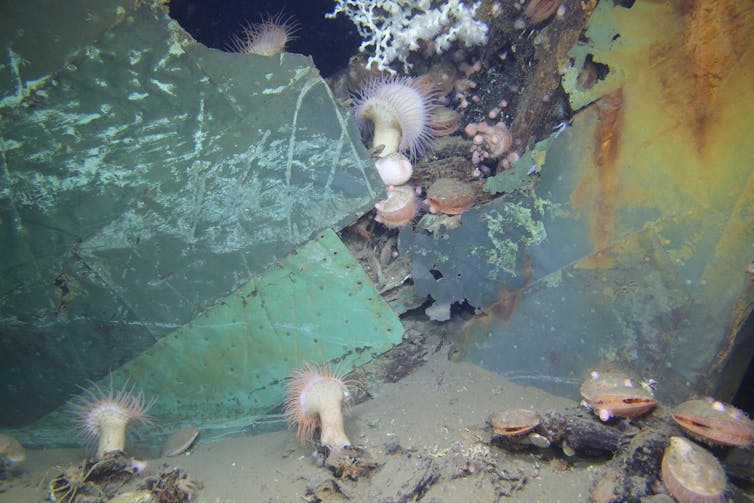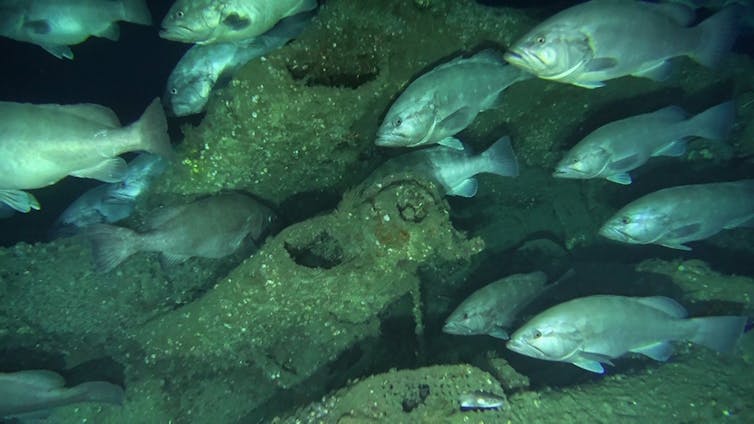Shipwrecks teem with underwater life, from microbes to sharks
Humans have sailed the world’s oceans for thousands of years, but they haven’t all reached port. Researchers estimate that there are some three million shipwrecks worldwide, resting in shallow rivers and bays, coastal waters and the deep ocean. Many sank during catastrophes – some during storms or after running aground, others in battle or collisions with other vessels.
Shipwrecks like the RMS Titanic, RMS Lusitania and USS Monitor conjure tales of human courage and sacrifice, sunken treasure and unsolved mysteries. But there’s another angle to their stories that doesn’t feature humans.
I have studied the biology of shipwrecks in the United States and internationally for 14 years. From this work, I have learned that shipwrecks are not only cultural icons but can also be biological treasures that create habitat for diverse communities of underwater life.
The USS Monitor, which sank off Cape Hatteras, North Carolina, in a storm on Dec. 31, 1862, is now a center for sea life.
Recently, I led an international team of biologists and archaeologists in disentangling the mysteries of how this transformation happens. Drawing on scientific advances from our team and international colleagues, our new study describes how wrecked vessels can have second lives as seabed habitats.
A new home for underwater life
Ships are typically made of metal or wood. When a vessel sinks, it adds foreign, artificial structure to the seafloor.
For example, the World War II tanker E.M. Clark sank on a relatively flat, sandy seabed in 1942 when it was torpedoed by a German submarine. To this day, the intact metal wreck looms over the North Carolina seafloor like an underwater skyscraper, creating an island oasis in the sand.
In this video narrated by NOAA research scientist Avery Paxton, sand tiger sharks hover above the wreck of the E.M. Clark off North Carolina, with vermilion snapper schooling nearby. Jacks and an invasive lionfish also appear.
The creatures that reside on and around sunken ships are so diverse and abundant that scientists often colloquially call these sites “living shipwrecks.” Marine life ranging from microscopic critters to some of the largest animals in the sea use shipwrecks as homes. Brilliantly colored corals and sponges blanket the wrecks’ surfaces. Silvery schools of baitfish dart and shimmer around the structures, chased by sleek, fast-moving predators. Sharks sometimes cruise around wrecks, likely resting or looking for prey.
The origin of a second life
A ship’s transformation from an in-service vessel into a thriving metropolis for marine life can seem like a fairy tale. It has a once-upon-a-time origin story – the wrecking event – and a sequence of life arriving on the sunken structure and beginning to blossom.
Tiny microbes invisible to the naked human eye initially settle on the wreck’s surface, forming a carpet of cells, called a biofilm. This coating helps to make the wreck structure suitable for larval animals like sponges and corals to settle and grow there.
Diverse sea creatures living on the 19th-century, wooden-hulled Ewing Bank wreck, which lies 2,000 feet (610 meters) deep in the Gulf of Mexico. NOAA
Larger animals like fish sometimes appear within minutes after a ship sinks. Small fish hide in the structure’s cracks and crevices, while large sharks glide around it. Sea turtles and marine mammals such as fur seals have also been spotted on wrecks.
Hot spots for biodiversity
Shipwrecks host quantities and varieties of marine life that can make them hot spots for biodiversity. The microbes that transform the wreck structure into habitat also enrich the surrounding sand. Evidence from deep Gulf of Mexico wrecks shows that a halo of increased microbial diversity radiates outward anywhere from 650 to 1,000 feet (200-300 meters) from the wreck. In the Atlantic Ocean, thousands of grouper, a type of reef fish highly valued by fishers, congregate around and inside shipwrecks.
Groupers and a conger eel, bottom center, on the wreck of the German submarine U-576 off the coast of North Carolina. NOAA
Shipwrecks can also serve as stepping stones across the ocean floor that animals use as temporary homes while moving from one location to another. This has been documented in areas of the world with dense concentrations of shipwrecks, such as off North Carolina, where storms and war have sunk hundreds of ships.
In this part of the ocean, popularly known as the “Graveyard of the Atlantic,” reef fish likely use the islandlike shipwrecks as corridors when moving north or south away from the equator to find favorable water temperatures as climate change warms the oceans. Scientists have also observed sand tiger sharks traveling from one wreck to another, possibly using the shipwrecks like rest stops during migration.
In the deep sea, life growing on shipwrecks can even generate energy. Tube worms that grow on organic shipwreck materials such as paper, cotton and wood host symbiotic bacteria that produce chemical energy. Such tube worm colonies have been documented in the Gulf of Mexico on the steel luxury yacht Anona.
Biological mysteries abound
Despite their biological value, shipwrecks can also threaten underwater life by altering or destroying natural habitats, causing pollution and spreading invasive species.
When a ship sinks, it can damage existing seafloor habitats. In a well-documented case in the Line Islands of the central Pacific, an iron shipwreck sank on a healthy coral reef. The iron infusion substantially decreased coral cover, and the reef was overcome by algae.
Ships may carry pollutants as fuel or cargo. As shipwrecks deteriorate in seawater, there is a risk that these pollutants may be released. The level of risk depends on how much of the pollutant the ship was carrying and how intact the wreck is. One recent investigation revealed that effects from shipwreck pollutants can be detected in microbes up to 80 years after the wreck.
Ships and planes wrecked in wartime can leak toxic materials for decades after they come to rest in the ocean.
Shipwrecks may also inadvertently assist the spread of invasive plants and animals that wreak biological havoc. Wrecks are new structures that invasive species can settle on, grow and use as a hub to expand to other habitats. Invasive cup coral has spread on World War II shipwrecks off Brazil. In Palmyra Atoll in the Pacific, a type of anemone called a corallimorph rapidly invaded a shipwreck and now threatens healthy coral reefs.
The future of shipwreck exploration
Shipwrecks create millions of study sites that scientists can use to ask questions about marine life and habitats. One of the greatest challenges is that many wrecks are undiscovered or in remote locations. Advances in technology can help researchers see into the most inaccessible areas of the ocean, not only to find shipwrecks but to better understand their biology.
Maximizing discovery will require biologists, archaeologists and engineers to work together to explore these special habitats. Ultimately, the more we learn, the more effectively we can conserve these historical and biological gems.
Avery Paxton, Research Marine Biologist, National Oceanic and Atmospheric Administration
Read more
about wildlife



